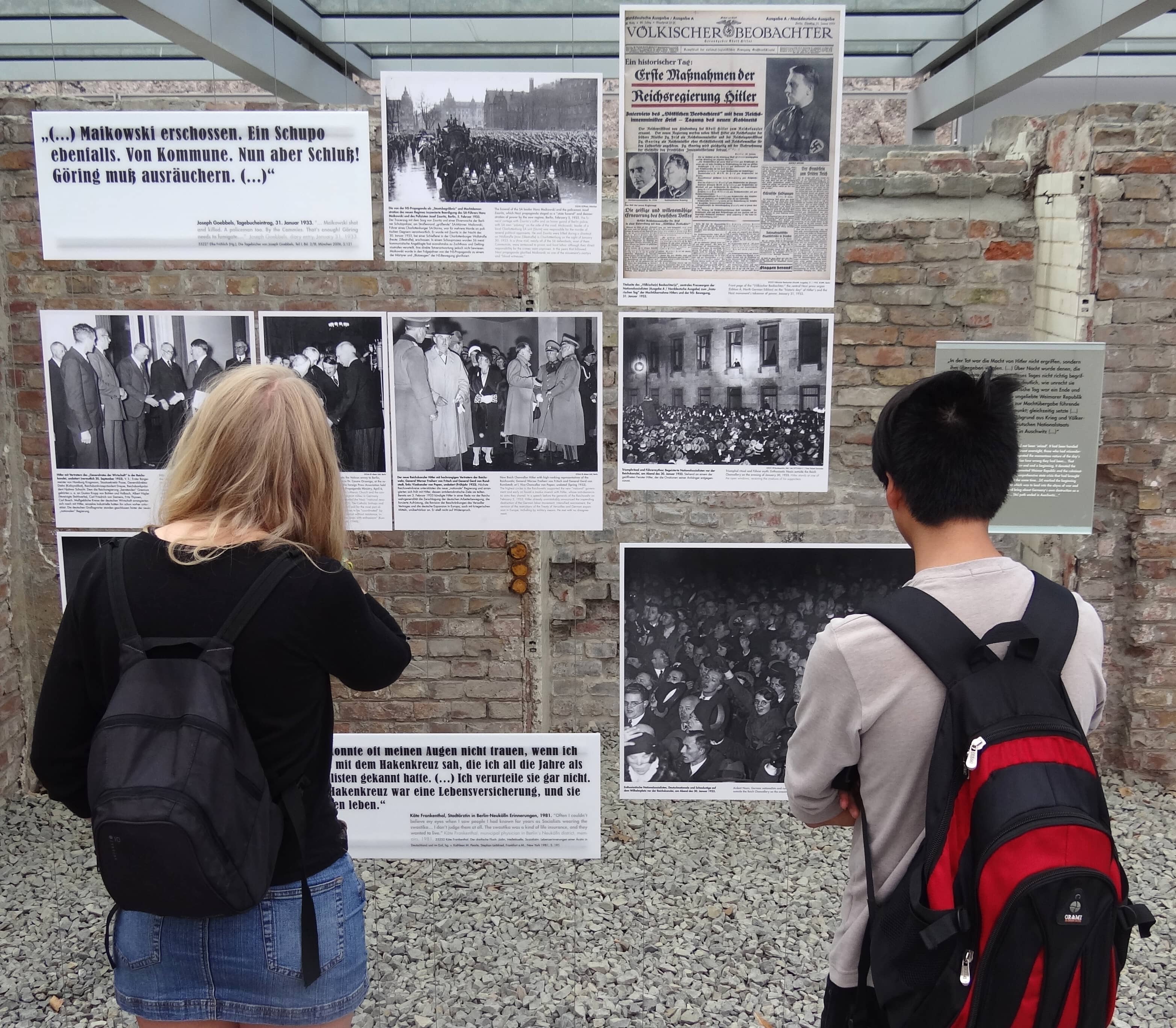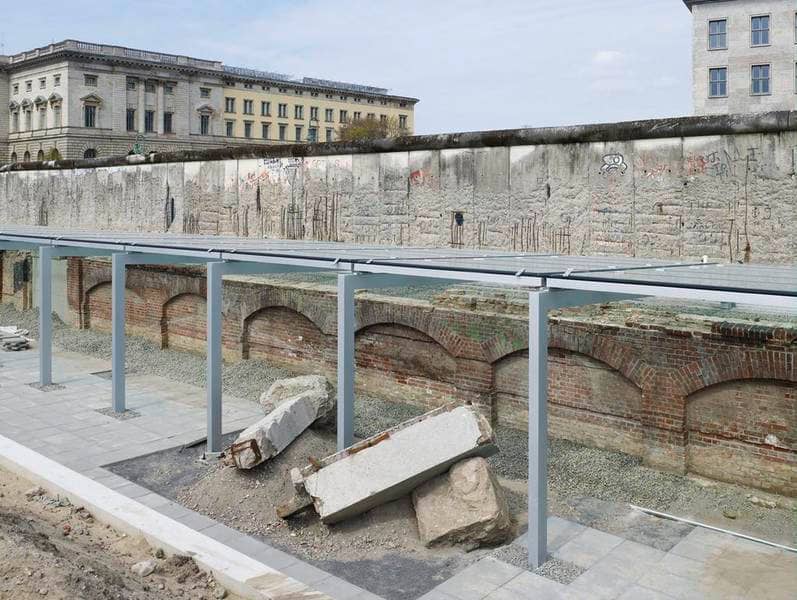
Topography of Terror Berlin
A vital documentation center on the former Gestapo HQ site, exposing the horrors of Nazism with free admission.

Highlights
Must-see attractions

Social
From TikTok & Reddit
Best Time
Fewer crowds, more reflection time

Topography of Terror Berlin
Best Time
Fewer crowds, more reflection time

Highlights
Must-see attractions
A vital documentation center on the former Gestapo HQ site, exposing the horrors of Nazism with free admission.
"A difficult but essential visit to understand the machinery of Nazi terror."

Allocate Sufficient Time
Don't rush. Allow at least 2-3 hours to fully absorb the exhibits and historical context.
Prepare for Emotional Impact
This is a heavy topic. Be prepared for a somber and thought-provoking experience.

Highlights
Discover the most iconic attractions and experiences

Former Gestapo Headquarters Site
Niederkirchnerstraße 8
Walk the grounds where Nazi terror was orchestrated. Preserved foundations offer a stark reminder of the past.

Outdoor Exhibition: 'Topography of Terror'
Outdoor grounds
An extensive outdoor exhibition detailing the crimes of the SS and Gestapo. A powerful visual narrative.

Indoor Exhibition: 'Topography of Terror'
Indoor exhibition space
In-depth documentation of Nazi persecution, offering a comprehensive historical account.

Remnants of the Berlin Wall
Adjacent to the site
See a preserved section of the Berlin Wall, a poignant reminder of a divided city.
Plans like a pro.
Thinks like you
Planning Your Visit
Understand the Weight of History
Free Admission, Essential Visit
Best Times
Insider Tips
from TikTok, Instagram & Reddit
Allocate Sufficient Time
Don't rush. Allow at least 2-3 hours to fully absorb the exhibits and historical context.
Prepare for Emotional Impact
This is a heavy topic. Be prepared for a somber and thought-provoking experience.
Combine with Other Sites
Consider visiting the Jewish Museum or other historical sites nearby for a broader understanding.
Utilize Introductory Film
Watch the short introductory film to get a good overview before exploring the main exhibits.
Tips
from all over the internet
Allocate Sufficient Time
Don't rush. Allow at least 2-3 hours to fully absorb the exhibits and historical context.
Prepare for Emotional Impact
This is a heavy topic. Be prepared for a somber and thought-provoking experience.
Combine with Other Sites
Consider visiting the Jewish Museum or other historical sites nearby for a broader understanding.
Utilize Introductory Film
Watch the short introductory film to get a good overview before exploring the main exhibits.
What Travellers Say
Reviews Summary
Visitors consistently praise the Topography of Terror for its powerful and essential historical documentation, highlighting its free admission and the profound impact of its exhibits. While the subject matter is heavy, most find it a crucial and well-presented site for understanding Nazi history. Some note that the emotional weight can be significant, and it's best approached with adequate time for reflection.
"A totally shocking museum of the horrors of the Nazi regime. It is an extensive documentation of the brutal treatment of certain sections of society that did not fit in with the party's ideals. An outside display covers the pre-war to post-war eras and inside the museum large displays are enhanced by information boards covering aspects of the subject in more detail.
A must visit museum if you are in Berlin.
Can be busy with school groups.
Free entrance."
Ivor Chapman
"A learning experience, it takes you through history chronologically, which is very interesting. We had a guide beforehand that had given us lots of stories of escape attempts and interesting facts which nicely framed the visit. Certainly woth a visit and quite mind blowing how relatively recent this was still the status Quo"
Tom Brennan
"Very very informative museum. You need to set aside a good time in order to see all pictures and descriptions. Using the audio guide in many languages is very useful."
Toncho Tonchev
What People Like
What People Dislike
Frequently Asked Questions
🚇 🗺️ Getting There
The Topography of Terror is easily accessible by public transport. Take the U-Bahn to Kochstraße/Checkpoint Charlie (U6) or Potsdamer Platz (U2), or the S-Bahn to Potsdamer Platz (S1, S2, S25, S26). Several bus lines also stop nearby.
Limited street parking is available in the vicinity, but it can be challenging to find. Public transportation is highly recommended for ease of access.
Yes, the site is well-suited for walking tours, especially the outdoor exhibition. Many guided tours of Berlin include this location.
🎫 🎫 Tickets & Entry
No, admission to the Topography of Terror is completely free. This makes it an essential and accessible historical site for everyone.
The Topography of Terror is typically open daily from 10 AM to 8 PM, but it's always a good idea to check their official website for the most up-to-date hours before your visit.
Yes, you can visit on weekends, but expect larger crowds. Weekday mornings are generally less busy, allowing for a more contemplative experience.
While there isn't always a formal guided tour offered by the museum itself, many private tour operators include the Topography of Terror in their Berlin historical tours.
🎫 🏛️ Onsite Experience
The Topography of Terror is a historical documentation center located on the site of former Nazi institutions, including the Gestapo and SS headquarters. It documents the crimes committed by the Nazi regime.
Most visitors recommend spending at least 2-3 hours to fully explore both the indoor and outdoor exhibitions and to allow time for reflection.
The content is sensitive and deals with the atrocities of the Holocaust. It's generally recommended for older children and teenagers who can understand and process the historical context.
The outdoor exhibition focuses on the history of the site and the Nazi institutions that were located there, while the indoor exhibition provides more detailed documentation and context on the persecution and crimes committed.
Photography is generally permitted for personal use in most areas, but it's always best to check for any specific restrictions within certain exhibits.
📸 📸 Photography
The preserved foundations of the former Gestapo and SS buildings offer a stark and powerful visual. The adjacent section of the Berlin Wall is also a significant photographic subject.
Yes, photography for personal use is generally allowed. However, be mindful of the solemn nature of the site and avoid intrusive photography.
Expect to capture images of historical remnants, informative exhibition panels, and the imposing architecture that speaks to the site's dark past.
For Different Travelers
Tailored advice for your travel style
👨👩👧 Families with Older Children
Recommendations:
* Watch the introductory film together to set the context.
* Focus on the outdoor exhibition first, as it's more visually engaging.
* Discuss the exhibits afterward to process the information and answer questions.
* Consider visiting the Jewish Museum nearby for a complementary perspective.
📚 History Enthusiasts & Students
Tips for history buffs:
* Allocate ample time (3+ hours) to thoroughly explore all exhibits.
* Read the detailed information panels carefully; they are rich with historical data.
* Consider joining a specialized historical walking tour that includes this site for deeper insights.
* Explore the related historical sites in Berlin, such as the Memorial to the Murdered Jews of Europe and the German Resistance Memorial Center.
🚶 Solo Travelers
Solo traveler advice:
* Go during off-peak hours (weekday mornings) for a more introspective experience.
* Take advantage of the introductory film to get oriented.
* Don't hesitate to ask staff if you have questions about the exhibits.
* Combine your visit with a walk along the nearby remnants of the Berlin Wall for added historical context.
Deep Dives
In-depth insights and expert knowledge
The Site's Dark Past
Visitors can explore the preserved cellars and foundations of these former buildings, offering a tangible connection to the past. The outdoor exhibition, 'Topography of Terror,' presents a comprehensive overview of the Nazi regime's crimes through extensive photographic and documentary material. It details the SS's role in the Holocaust, the establishment of concentration and extermination camps, and the widespread use of forced labor.
This site is not just a museum; it's a place of remembrance and a stark warning. The free admission ensures that this crucial history is accessible to everyone, encouraging reflection on how such atrocities can occur and the importance of vigilance against intolerance and extremism.
Understanding the Exhibitions
The outdoor exhibition complements the indoor displays by focusing on the physical location and its significance. It uses large-format photographs and informative panels to illustrate the daily operations of the Gestapo and SS, the persecution of various groups, and the impact of the war. This open-air display allows visitors to walk through the history while standing on the actual historical ground.
Many visitors find it beneficial to watch the short introductory film (around 6 minutes) before exploring the main exhibitions. This film provides a concise overview of the site's history and the context of Nazi terror, helping to orient visitors and enhance their understanding of the exhibits.
Beyond the Terror: The Berlin Wall
While the Topography of Terror focuses on the Nazi era, the presence of the Berlin Wall here creates a layered historical experience. It highlights how Berlin has been a site of immense historical significance, marked by both totalitarian regimes and subsequent struggles for freedom and reunification.
Seeing the Wall in proximity to the former Gestapo headquarters underscores the continuous historical narrative of oppression and resistance that has shaped Berlin. It offers a broader perspective on the city's complex past and its journey towards becoming a symbol of peace and unity.






Social
from TikTok, Instagram & Reddit